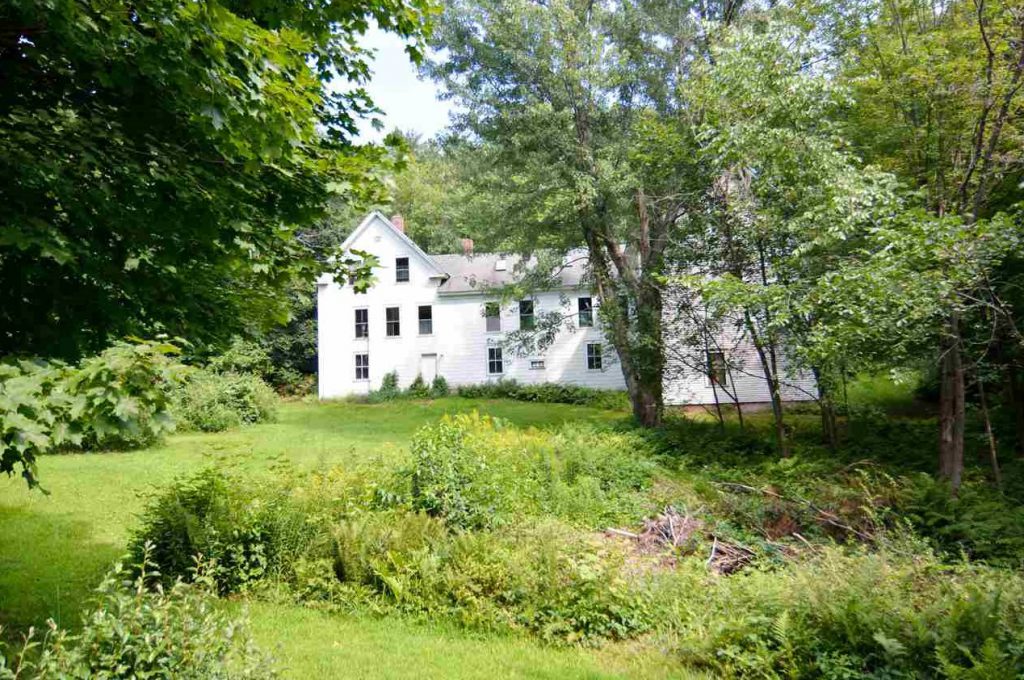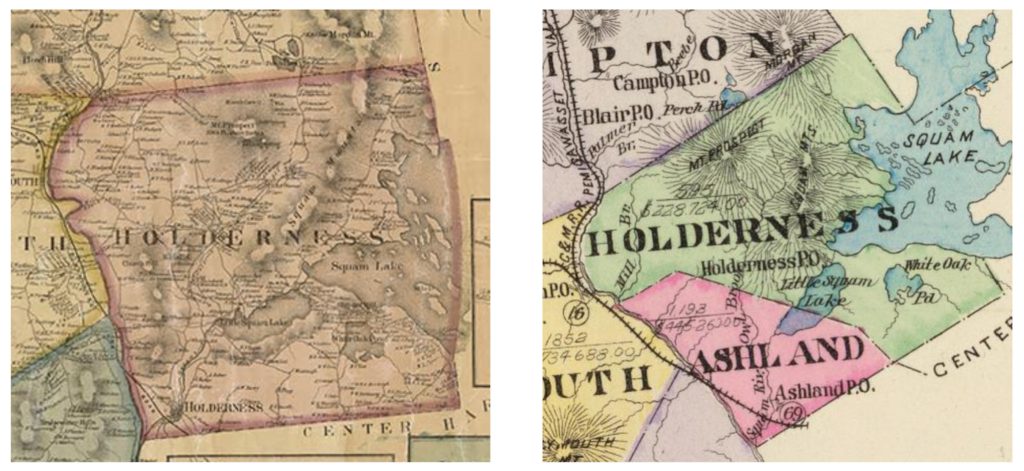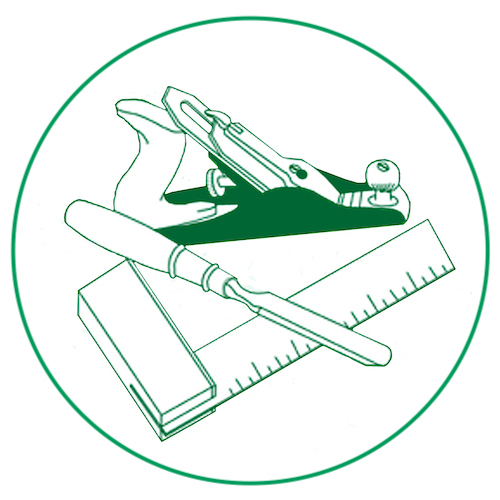
When we bought this house, we knew only that it had stayed in the Thompson family, that it had been a working farm into the early 20th century, and that Prentice Hammond—from whom we bought it at the end of 2019—had taken it on in 2007 so that a seriously ill friend could continue living there.
But what happened between Nathaniel’s sudden death in 1785 and Prentice’s buying the house in 2009? As an amateur genealogist, I wanted to know more. What was the life story of this house? Or, more practically, how do you research the history of your old house?
I knew how to track down the histories of people; surely, I could use those skills to excavate the story of the land, the house, and their owners over the 235 years since Nathaniel’s death. Prentice’s wife Deb had given us a copy of Nathaniel’s story, along with photographs of the gravestones in the Thompson family cemetery down by the river. Both became starting points.

I developed pages on Ancestry.com for Nathaniel, Elizabeth, and some of their children and grandchildren. I hunted for key events in their lives, along with wills, probate documents, and historical events that might have affected them. I combed through the files Prentice and Deb had given us, which detailed Prentice’s purchase and alluded to two earlier owners.
I extracted every reference to specific deeds, along with their citations. I began additional Ancestry pages for each individual mentioned, along with some of their descendants. Who had they been? Had they known each other, and how? What roles had they played in Holderness which, in 1868, would split off a southwestern section as the town of Ashland?

Then I discovered the Grafton County Registry of Deeds, which had just reopened from its COVID-19 shuttering to allow limited visits by appointment. You may have to be something of a historian yourself to understand the excitement of pouring through old documents, recognizing that the people you are trying to learn about once handled the pages and entered the signatures in your hands. It may be a “you-kind-of-had-to-be-there” thing. I can only tell you I was all but jumping up and down as I filled in missing details. What I didn’t find during my visit turned out to be available through the Registry’s online AVA site.
The passage of the land and house from one owner to another down to the present had emerged.
In writing this post, I am mindful that Devon has warned me not to let out too much of my inner historian. I can’t say I’ve succeeded. I find this stuff way too interesting. Not everyone does. So, for now, I’ll just give you the list of who has lived on the land over the years. Over time, I’ll add the stories of these owners. You’ll be able to find them all under the Historical posts.
In the meantime, stay tuned for posts about our own part in the story, as we take you through our journey with the land and its house.

Here’s what I found for the owners of record. The years represent the periods of time during which they held the land and the house:
1770-1785: Nathaniel Thompson. Died as the result of an accident and was buried in Durham, New Hampshire. I have not yet been able to locate his grave.
1785-1816: Elizabeth Stevens Thompson. Widow of Nathaniel. Buried in the family cemetery.
1816-1830s: Rev. Samuel Thompson. A younger son of Nathaniel and Elizabeth. A shoemaker, and deacon with the Freewill Baptist Church, which was actively involved in the abolitionist movement. Buried in the family cemetery.
1834?-1862: John Hayes Thompson. One of Samuel’s sons with his first wife Polly Chandler. John Hayes and four of his own sons fought in the Civil War. He died of typhoid at Hilton Head, South Carolina in 1862 while serving in the war, and is buried in the family cemetery. It was John Hayes who built the house.
1862-1864: Charlotte Baker Thompson. I have not yet found John Hayes Thompson’s will. Records suggest that when he knew he was dying, he wrote down his last wishes in South Carolina, but I have not located them. I speculate that his widow Charlotte inherited the house at the age of 56. John’s step-brother managed the sale of the land and house in 1864 to an old friend of John’s, William Drake.
1864-1873: William P. Drake. William Drake owned a paper mill in Ashland. He, too, enlisted to serve during the Civil War. He and his wife Mary owned the house during the time that Holderness and Ashland split in 1868. I have not yet discovered what caused his death in 1873 at the age of 50.
1873-1875: Mary J. Drake. With William’s death in 1873, the house went to his widow Mary, with their two daughters Mary and Maria.
1875-1888: Edward L. Shepard. William’s widow Mary J. Drake sold the house to Edward L. Shepard, a decorated veteran of the Civil War. A year later, Jeremiah Calley deeded him rights to build a well.
1888-1950: Marsena C. Blake. Originally from Thornton, he worked in Ashland as a barber, a farmer, and a poultry farmer. He died in 1948. A widower, Marsena had no living children by the time of his death. The executor of his estate brokered the sale in 1950.
1950-1995: Lawrence & Aura Harriet Drake Berry. After buying the property in 1950, the Berrys seem to have transferred a piece of the land to Herman A. Huckins in 1951. Mr. Huckins, as far as I can tell from the deeds, paid part of the Berrys’ mortgage, in exchange for that segment of land. The following day, he then paid them a symbolic dollar, for which he received the deed for that portion of the property.
1995-2007 (2009): Michael Agnelli and Marika Hughes Agnelli. Michael Agnelli came to Ashland from Brooklyn, New York, by way of California. Marika Hughes was local.
2007 (2009)-2019: Prentice Hammond. Prentice assumed responsibility for the property in order to help his friend Michael Agnelli—who was dealing with cancer—to continue living there. Prentice then purchased it in 2009. Between 2013 and 2019 he, his brother, and his wife Deb prepared the house for renovation, expecting to relocate there.
2019-Present: Linda Barnes and Antonio “Devon” Thibeault. Following changes to their relocation plans, Prentice sold the house to Devon and me, closing on December 31st. The official sale year is 2020.
Resources
10 Ways to Research Your Home’s History: https://savingplaces.org/stories/preservation-tips-toolshomep-10-ways-research-homes-history
How to Look Up the History of Your Home: https://www.architecturaldigest.com/story/property-history-how-to-look-up-the-history-of-your-home
How to Research the History of Your House: https://www.thisoldhouse.com/21015083/how-to-research-the-history-of-your-house
To check out the individual family headstones, you can look at Find a Grave’s page for Thompson Street Cemetery Memorials: https://www.findagrave.com/cemetery/2611725/memorial-search#srp-top

Aiteen Zhang
Dear Linda,
Thanks for the updates! Congratulations! Th he house look nice and big. Both of you will be very busy renovating the house.
Keep in touch!
-Aiteen
Judith Bernstein
What a checkered, interesting history. This is the stuff of short stories. We owned a grand old house in west newton that was built just before the civil war, and had a wonderful time tracking down the history and some images from the 1970’s. We left it for a boston apartment when we no longer needed a three generation space, but that house and its history has never left me. Welcome,neighbor!
Linda Barnes
Yes, part of why we find the history so interesting is in the ways it reflects key developments in both the region and the country at the time. It is very good to be in the neighborhood. We’ll very much look forward to seeing you and Edward.
Ruben Hopwood
Such an engaging and thrilling history to read. I am also enthralled (addicted) to such history sleuthing and empathize with Devon’s warning to stay far enough from the edge not to fall into this absorbing black hole. You’ll have good company if you fall in nevertheless!! I am so excited for you both and desirous of being elbows deep in the work we’re that possible. I eagerly await further blogs and the ongoing journaling of the past and present of Thompson Farm and it’s rehabilitation. Thank you for creating this blog! Perhaps you can even try a vlog or two along the way for anything really exciting!
Linda Barnes
Ah, but I fell over that edge years ago, in part because of the good company I found there! You in particular would appreciate that we have been able to salvage almost all of the original 185-year-old wood from the studs, floors, and walls that Devon has removed. With few exceptions, it is all utterly solid and whole, so we are reusing it for the new framing and building (stay tuned for pictures). Likewise, we will repurpose the bricks from the original chimney we removed. I very much hope you, Melanie, and the kids can come out to visit, but also do consider coming out for a day or so if you feel like working again on an old house!
Donene Williams
I love the story so far! Thanks for the details, and I like the historian’s perspective.
Linda Barnes
One of the most fun things about the historical stuff is trying to read past tiny details, to understand what they actually meant in the lives of these individuals. Those are the stories I’m looking forward to telling.
Mary Benton
Fascinating history. I thought of you when I came across this house. It reminds me so much of Harry and Betsey’s home in Peacham, VT, which I believe was moved up from Connecticut. https://inhabitat.com/sublime-net-positive-energy-farmhouse-pays-homage-to-the-local-vernacular/
Linda Barnes
Mary, thank you so much for the link! I had heard about their house being the outcome of two buildings being moved from different locations, and then being joined in Peacham, but had never actually seen pictures. And yes, there are many reminders.
I think of you every time I go out into the yard and see the many butterflies and moths. Eventually, we want to remove the invasive plants (which have been busy invading), but for now, are focusing and adding what we can. I just put in six bee-balm plants that I got from a neighbor, and thought of you as I planted them.
Mary Benton
How lovely!
Anafidelia Tavares
This is so exciting. And there are people like me who like historical details so maybe you can have History Time posts for that crowd. And there are other folks who (also like me) like details about renovations and carpentry so Devon would gets to wax poetic too. I feel like the story of this house has the makings for a book…
Linda Barnes
Book or no, that’s what we were hoping. In this case, the two really intersect. As we work closely with the house, we learn the fine details of how it was put together (stories to come). In turn, learning about the people who actually did that work makes it come alive. Given that these people are all buried down at the end of the land, it has come to feel as though they may not be biological ancestors. They are, however, house ancestors and we feel like the latest in a long line of custodians of the house and the land.
Veda Wright
I really enjoyed reading this. Thank you and Devon. Looking forward to the next installation. It’ll be great when you have your open house😊
Linda Barnes
Thank you!
Sasha Barnes
This is so interesting Linda – I imagine it’s nice to be surrounded by so many lives lived and take your place in the house’s lineage.
Linda Barnes
Exactly how it feels. Although the series of owners are not our actual ancestors, they do feel like house ancestors, and we like custodians to whom the house has been entrusted for a time.